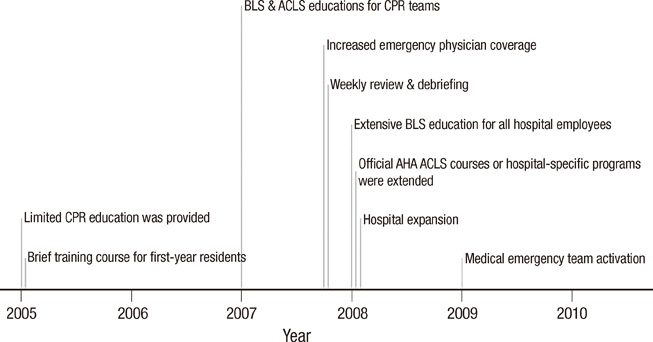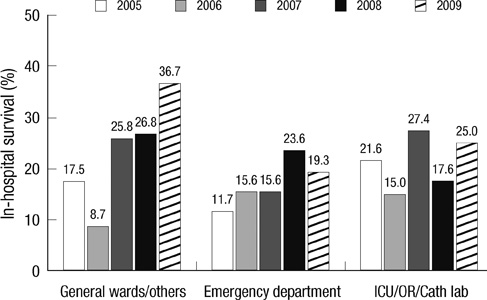J Korean Med Sci.
2012 Feb;27(2):146-152. 10.3346/jkms.2012.27.2.146.
Improving Survival Rate of Patients with In-Hospital Cardiac Arrest: Five Years of Experience in a Single Center in Korea
- Affiliations
-
- 1Department of Emergency Medicine, Samsung Medical Center, Sungkyunkwan University School of Medicine, Seoul, Korea. drjij@skku.edu
- 2Department of Medicine, Graduate School, Kyung Hee University, Seoul, Korea.
- KMID: 1120151
- DOI: http://doi.org/10.3346/jkms.2012.27.2.146
Abstract
- The aim of this study was to describe the cause of the recent improvement in the outcomes of patients who experienced in-hospital cardiac arrest. We retrospectively analyzed the in-hospital arrest registry of a tertiary care university hospital in Korea between 2005 and 2009. Major changes to the in-hospital resuscitation policies occurred during the study period, which included the requirement of extensive education of basic life support and advanced cardiac life support, the reformation of cardiopulmonary resuscitation (CPR) team with trained physicians, and the activation of a medical emergency team. A total of 958 patients with in-hospital cardiac arrest were enrolled. A significant annual trend in in-hospital survival improvement (odds ratio = 0.77, 95% confidence interval 0.65-0.90) was observed in a multivariate model. The adjusted trend analysis of the return of spontaneous circulation, six-month survival, and survival with minimal neurologic impairment upon discharge and six-months afterward revealed similar results to the original analysis. These trends in outcome improvement throughout the study were apparent in non-ICU (Intensive Care Unit) areas. We report that the in-hospital survival of cardiac arrest patients gradually improved. Multidisciplinary hospital-based efforts that reinforce the Chain of Survival concept may have contributed to this improvement.
MeSH Terms
Figure
Cited by 1 articles
-
Incidence of Adult In-Hospital Cardiac Arrest Using National Representative Patient Sample in Korea
Yuri Choi, In Ho Kwon, Jinwoo Jeong, Junyoung Chung, Younghoon Roh
Healthc Inform Res. 2016;22(4):277-284. doi: 10.4258/hir.2016.22.4.277.
Reference
-
1. Sandroni C, Nolan J, Cavallaro F, Antonelli M. In-hospital cardiac arrest: incidence, prognosis and possible measures to improve survival. Intensive Care Med. 2007. 33:237–245.2. Thom T, Haase N, Rosamond W, Howard VJ, Rumsfeld J, Manolio T, Zheng ZJ, Flegal K, O'Donnell C, Kittner S, Lloyd-Jones D, Goff DC Jr, Hong Y, Adams R, Friday G, Furie K, Gorelick P, Kissela B, Marler J, Meigs J, Roger V, Sidney S, Sorlie P, Steinberger J, Wasserthiel-Smoller S, Wilson M, Wolf P. American Heart Association Statistics Committee and Stroke Statistics Subcommittee. Heart disease and stroke statistics: 2006 update: a report from the American Heart Association Statistics Committee and Stroke Statistics Subcommittee. Circulation. 2006. 113:e85–e151.3. Ehlenbach WJ, Barnato AE, Curtis JR, Kreuter W, Koepsell TD, Deyo RA, Stapleton RD. Epidemiologic study of in-hospital cardiopulmonary resuscitation in the elderly. N Engl J Med. 2009. 361:22–31.4. Bloom HL, Shukrullah I, Cuellar JR, Lloyd MS, Dudley SC Jr, Zafari AM. Long-term survival after successful inhospital cardiac arrest resuscitation. Am Heart J. 2007. 153:831–836.5. Perkins GD, Soar J. In hospital cardiac arrest: missing links in the chain of survival. Resuscitation. 2005. 66:253–255.6. Smith GB. In-hospital cardiac arrest: is it time for an in-hospital 'chain of prevention'? Resuscitation. 2010. 81:1209–1211.7. Moretti MA, Cesar LA, Nusbacher A, Kern KB, Timerman S, Ramires JA. Advanced cardiac life support training improves long-term survival from in-hospital cardiac arrest. Resuscitation. 2007. 72:458–465.8. Spearpoint KG, Gruber PC, Brett SJ. Impact of the Immediate Life Support course on the incidence and outcome of in-hospital cardiac arrest calls: an observational study over 6 years. Resuscitation. 2009. 80:638–643.9. Thigpen K, Davis SP, Basol R, Lange P, Jain SS, Olsen JD, Erickson BR, Schuchard TN, Aufderheide TP. Implementing the 2005 American Heart Association guidelines, including use of the impedance threshold device, improves hospital discharge rate after in-hospital cardiac arrest. Respir Care. 2010. 55:1014–1019.10. Edelson DP, Litzinger B, Arora V, Walsh D, Kim S, Lauderdale DS, Vanden Hoek TL, Becker LB, Abella BS. Improving in-hospital cardiac arrest process and outcomes with performance debriefing. Arch Intern Med. 2008. 168:1063–1069.11. Sandroni C, Ferro G, Santangelo S, Tortora F, Mistura L, Cavallaro F, Caricato A, Antonelli M. In-hospital cardiac arrest: survival depends mainly on the effectiveness of the emergency response. Resuscitation. 2004. 62:291–297.12. Konrad D, Jäderling G, Bell M, Granath F, Ekbom A, Martling CR. Reducing in-hospital cardiac arrests and hospital mortality by introducing a medical emergency team. Intensive Care Med. 2010. 36:100–106.13. Jacobs I, Nadkarni V, Bahr J, Berg RA, Billi JE, Bossaert L, Cassan P, Coovadia A, D'Este K, Finn J, Halperin H, Handley A, Herlitz J, Hickey R, Idris A, Kloeck W, Larkin GL, Mancini ME, Mason P, Mears G, Monsieurs K, Montgomery W, Morley P, Nichol G, Nolan J, Okada K, Perlman J, Shuster M, Steen PA, Sterz F, Tibballs J, Timerman S, Truitt T, Zideman D. International Liaison Committee on Resuscitation. American Heart Association. European Resuscitation Council. Australian Resuscitation Council. New Zealand Resuscitation Council. Heart and Stroke Foundation of Canada. InterAmerican Heart Foundation. Resuscitation Councils of Southern Africa. ILCOR Task Force on Cardiac Arrest and Cardiopulmonary Resuscitation Outcomes. Cardiac arrest and cardiopulmonary resuscitation outcome reports: update and simplification of the Utstein templates for resuscitation registries: a statement for healthcare professionals from a task force of the International Liaison Committee on Resuscitation (American Heart Association, European Resuscitation Council, Australian Resuscitation Council, New Zealand Resuscitation Council, Heart and Stroke Foundation of Canada, InterAmerican Heart Foundation, Resuscitation Councils of Southern Africa). Circulation. 2004. 110:3385–3397.14. International Liaison Committee on Resuscitation. 2005 International Consensus on Cardiopulmonary Resuscitation and Emergency Cardiovascular Care Science with Treatment Recommendations. Part 8: Interdisciplinary topics. Resuscitation. 2005. 67:305–314.15. Prohl J, Röther J, Kluge S, de Heer G, Liepert J, Bodenburg S, Pawlik K, Kreymann G. Prediction of short-term and long-term outcomes after cardiac arrest: a prospective multivariate approach combining biochemical, clinical, electrophysiological, and neuropsychological investigations. Crit Care Med. 2007. 35:1230–1237.16. Deyo RA, Cherkin DC, Ciol MA. Adapting a clinical comorbidity index for use with ICD-9-CM administrative databases. J Clin Epidemiol. 1992. 45:613–619.17. Ferreira FL, Bota DP, Bross A, Mélot C, Vincent JL. Serial evaluation of the SOFA score to predict outcome in critically ill patients. JAMA. 2001. 286:1754–1758.18. Vincent JL, de Mendonça A, Cantraine F, Moreno R, Takala J, Suter PM, Sprung CL, Colardyn F, Blecher S. Use of the SOFA score to assess the incidence of organ dysfunction/failure in intensive care units: results of a multicenter, prospective study. Working group on "sepsis-related problems" of the European Society of Intensive Care Medicine. Crit Care Med. 1998. 26:1793–1800.19. Larkin GL, Copes WS, Nathanson BH, Kaye W. Pre-resuscitation factors associated with mortality in 49,130 cases of in-hospital cardiac arrest: a report from the National Registry for Cardiopulmonary Resuscitation. Resuscitation. 2010. 81:302–311.20. Shin TG, Choi JH, Jo IJ, Sim MS, Song HG, Jeong YK, Song YB, Hahn JY, Choi SH, Gwon HC, Jeon ES, Sung K, Kim WS, Lee YT. Extracorporeal cardiopulmonary resuscitation in patients with inhospital cardiac arrest: a comparison with conventional cardiopulmonary resuscitation. Crit Care Med. 2011. 39:1–7.21. Tian J, Kaufman DA, Zarich S, Chan PS, Ong P, Amoateng-Adjepong Y, Manthous CA. American Heart Association National Registry for cardiopulmonary Resuscitation Investigators. Outcomes of critically ill patients who received cardiopulmonary resuscitation. Am J Respir Crit Care Med. 2010. 182:501–506.22. Bhanji F, Mancini ME, Sinz E, Rodgers DL, McNeil MA, Hoadley TA, Meeks RA, Hamilton MF, Meaney PA, Hunt EA, Nadkarni VM, Hazinski MF. Part 16: education, implementation, and teams: 2010 American Heart Association Guidelines for Cardiopulmonary Resuscitation and Emergency Cardiovascular Care. Circulation. 2010. 122:S920–S933.23. Soar J, Monsieurs KG, Ballance JH, Barelli A, Biarent D, Greif R, Handley AJ, Lockey AS, Richmond S, Ringsted C, Wyllie JP, Nolan JP, Perkins GD. European Resuscitation Council Guidelines for Resuscitation 2010 Section 9. Principles of education in resuscitation. Resuscitation. 2010. 81:1434–1444.24. Chamberlain DA, Hazinski MF. European Resuscitation Council. American Heart Association. Heart and Stroke Foundation of Canada. Australia and New Zealand Resuscitation Council. Resuscitation Council of Southern Africa. Consejo Latino-Americano de Resuscitación. Education in resuscitation. Resuscitation. 2003. 59:11–43.25. Abella BS, Alvarado JP, Myklebust H, Edelson DP, Barry A, O'Hearn N, Vanden Hoek TL, Becker LB. Quality of cardiopulmonary resuscitation during in-hospital cardiac arrest. JAMA. 2005. 293:305–310.26. Dane FC, Russell-Lindgren KS, Parish DC, Durham MD, Brown TD. In-hospital resuscitation: association between ACLS training and survival to discharge. Resuscitation. 2000. 47:83–87.27. Lim SY, Park SY, Park HK, Kim M, Park HY, Lee B, Lee JH, Jung EJ, Jeon K, Park CM, Ko MG, Park MR, Nam JM, Won SY, Jung JH, Cho SH, Suh GY. Early impact of medical emergency team implementation in a country with limited medical resources: a before-and-after study. J Crit Care. 2011. 26:373–378.28. Fredriksson M, Aune S, Thorén AB, Herlitz J. In-hospital cardiac arrest: an Utstein style report of seven years experience from the Sahlgrenska University Hospital. Resuscitation. 2006. 68:351–358.29. Skrifvars MB, Castrén M, Aune S, Thoren AB, Nurmi J, Herlitz J. Variability in survival after in-hospital cardiac arrest depending on the hospital level of care. Resuscitation. 2007. 73:73–81.30. Carr BG, Kahn JM, Merchant RM, Kramer AA, Neumar RW. Inter-hospital variability in post-cardiac arrest mortality. Resuscitation. 2009. 80:30–34.
- Full Text Links
- Actions
-
Cited
- CITED
-
- Close
- Share
- Similar articles
-
- In-hospital Pediatric Cardiopulmonary Resuscitation According to Pediatric Utstein Template
- Outcome of Resuscitation Attempts in Victims with Non Traumatic Out-of-Hospital Cardiac Arrest
- Cardiac Arrest. A Report of Application of External Cardiac Massage on Three Patients
- Outcome of Nontraumatic Prehospital Cardiac Arrest
- Analysis of Prognostic Factors for Return of Spontaneous Circulation and Survival in Elderly Patients with Cardiac Arrest



